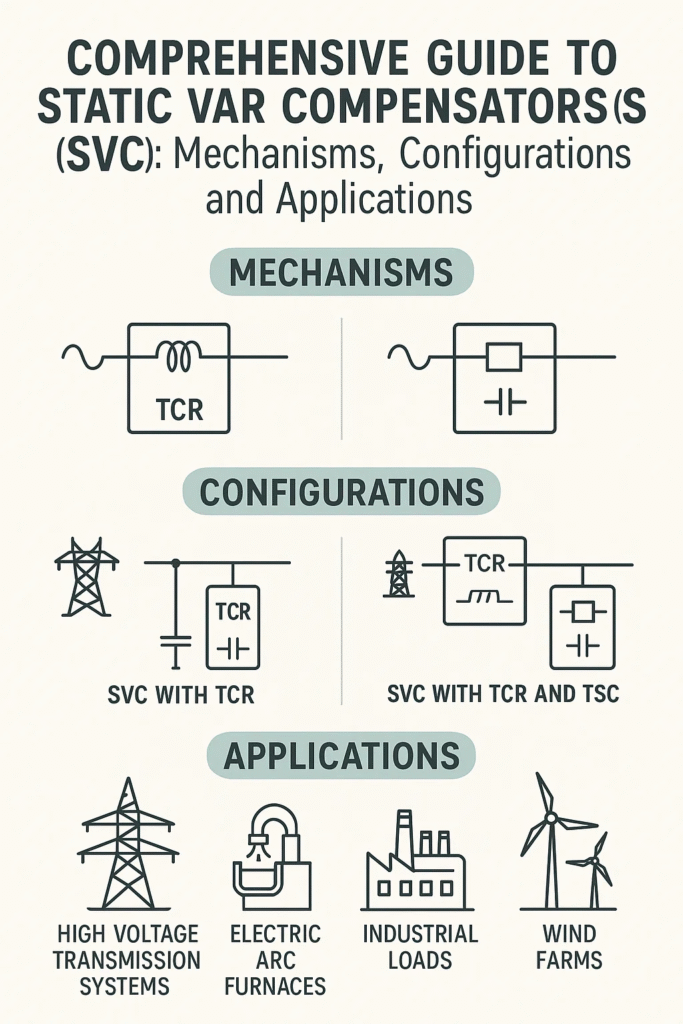In modern electric power systems, maintaining voltage stability, enhancing power factor, and improving overall transmission efficiency are critical. One technology at the forefront of dynamic reactive power control is the Static Var Compensator (SVC)—a key member of the FACTS (Flexible AC Transmission Systems) family.
SVCs are widely employed in both industrial and transmission-level power systems to dynamically control reactive power, thereby stabilizing voltage levels during load changes, faults, and disturbances. This guide explores the underlying mechanisms, main configurations, and diverse applications of SVCs, with insights into their transformative impact on power system performance.
Fundamental Mechanisms of SVC Operation
At its core, an SVC maintains or adjusts voltage levels by injecting or absorbing reactive power. Unlike traditional capacitor banks and reactors, it offers continuous and dynamic control.
Key Functional Elements
- Thyristor-Controlled Reactor (TCR):
- Uses thyristors to regulate current through a reactor.
- Provides variable inductive reactance, absorbing reactive power.
- Thyristor-Switched Capacitor (TSC):
- Connects or disconnects capacitors rapidly using thyristors.
- Supplies reactive power in discrete steps.
- Harmonic Filters:
- Mitigate harmonics generated by thyristor switching.
- Designed for site-specific harmonic profiles.
- Control Systems:
- Typically digital, implementing PI controllers or advanced algorithms.
- Monitor voltage, reactive power demand, and system stability.
How SVC Balances Reactive Power
The SVC’s control system modulates the firing angle of thyristors in TCRs and toggles TSCs to maintain the desired voltage at the point of connection. These changes can happen in milliseconds, ensuring rapid response to disturbances.
Typical Configurations of SVC Systems
SVCs are custom-built for their environment. Let’s explore common configurations:
- TCR + Fixed Capacitor (FC)
- Simplest form.
- Continuous inductive control, but reactive power injection is fixed.
- TCR + TSC
- Most popular configuration.
- Combines continuous and discrete control.
- Offers enhanced flexibility and harmonic reduction.
- TSC + FC
- Less used due to limited inductive control.
- Simpler and cheaper, but less dynamic.
- TCR + TSC + Harmonic Filters
- Advanced configuration for systems with stringent harmonic constraints.
- Often deployed in industrial grids with nonlinear loads.

Applications in Power Systems
SVCs have found widespread use across both high-voltage transmission networks and low-voltage industrial systems. Their roles vary according to context.
- Voltage Stabilization in Transmission Networks
- Regulates local bus voltages to maintain system stability.
- Improves voltage profiles and mitigates voltage sags.
- Industrial Load Compensation
- Mitigates large, cyclical reactive demands (e.g., electric arc furnaces).
- Ensures power factor correction and voltage control in large plants.
- Traction Systems
- Used in railway power systems for stability and reactive support.
- Helps manage fluctuating loads from electric locomotives.
- Integration of Renewable Energy
- Stabilizes voltages affected by intermittent solar and wind generation.
- Improves grid robustness with distributed renewables.
- Grid Reliability and Fault Ride-Through
- Enhances grid’s fault tolerance.
- Enables faster recovery after disturbances or faults.
Control Strategies and Modeling Approaches
Efficient operation of SVCs relies heavily on robust control strategies and accurate modeling.
Control Strategies
- Voltage Feedback Control:
- Uses feedback loops to maintain target voltage.
- Reactive Power Compensation:
- Responds to reactive power imbalance to stabilize system.
- Coordinated Control in Multi-SVC Systems:
- Synchronizes multiple SVCs for optimized grid response.
Modeling Techniques - Simplified Models:
- Represent SVC as a variable susceptance.
- Suitable for steady-state studies.
- Detailed Models:
- Include thyristor dynamics, control loops, and harmonic behavior.
- Essential for dynamic and transient simulations.
- Hybrid Modeling:
- Combines both approaches for efficient real-time analysis.
Performance Assessment
To ensure the effectiveness of an SVC, engineers assess:
- Dynamic Response Time: Millisecond-scale modulation capability.
- Voltage Regulation Range: Minimum and maximum voltage that can be maintained.
- Harmonic Performance: Compliance with IEEE/IEC standards.
- System Stability Contribution: How well the SVC supports system damping.
Simulation platforms like MATLAB/Simulink, PSCAD, and DIgSILENT PowerFactory are commonly used for performance analysis.
Advantages and Limitations
Advantages
- Continuous reactive power control.
- Rapid response to voltage changes.
- Improves power system reliability and flexibility.
- Reduces transmission losses.
- Enhances load power factor.
Limitations - High initial investment cost.
- Complex installation and maintenance.
- Harmonic issues require advanced filtering.
- Thyristor switching may create electromagnetic interference.
Future Outlook and Emerging Trends
The evolution of SVCs continues with innovations in:
- Hybrid FACTS Devices: Integration with STATCOMs and energy storage.
- AI-Based Control Algorithms: Improved responsiveness and adaptability.
- Modular Designs: Scalable and cost-effective implementations.
- Digital Twin Technology: Real-time simulation and predictive maintenance.
As power systems become more decentralized and renewable-heavy, SVCs are likely to evolve toward smarter, more integrated solutions.
Conclusion
Static Var Compensators (SVCs) have cemented their role as indispensable assets in reactive power management. Through dynamic voltage control and power factor correction, they empower both transmission grids and industrial systems to operate more reliably and efficiently.
Their blend of advanced thyristor-based technology, intelligent control, and robust filtering makes them suitable for the complex demands of today’s power systems. With ongoing advancements and increasing adoption, SVCs continue to shape the future of grid stability and sustainability.
